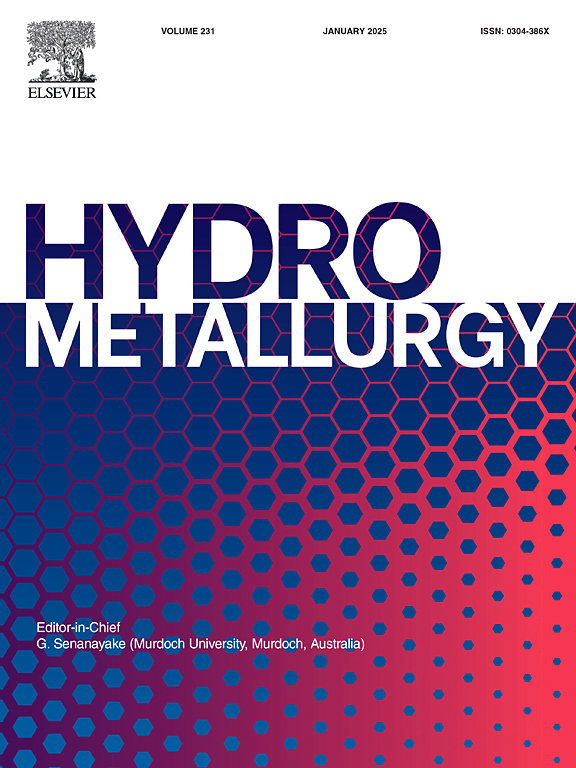Scandium extraction from sulfate media with di-(2-ethylhexyl) phosphoric acid in decane or toluene mixed with proton-donor additives
IF 4.8
2区 材料科学
Q1 METALLURGY & METALLURGICAL ENGINEERING
引用次数: 0
Abstract
In this work, the effect of proton-donor additives (monocarboxylic acids, aliphatic alcohols, and phenol derivatives) on scandium extraction from sulfate solutions with di-(2-ethylhexyl)phosphoric acid (D2EHPA, HR) in decane or toluene as the diluent was investigated. It was shown that addition of these additives into the organic phase leads to an antagonistic effect, i.e., to a decrease in the extraction of scandium, and thus improves the stripping efficiency. The antagonistic effect decreases in the series octanol >4-t-butylphenol > > octanoic acid. The low activity of octanoic acid is due to self-association, which significantly prevents the formation of intermolecular associates between D2EHPA and the monocarboxylic acid. Alcohols and phenols form stable associates with D2EHPA, which leads to a decrease in scandium extraction. Analysis of the interphase scandium distribution as well as the nuclear magnetic resonance (NMR) and infrared (IR) spectra of the loaded organic phases showed that the composition of the extracted scandium compound in the mixed extractant system containing D2EHPA and octyl alcohol is ScR3. In the case of D2EHPA in inert diluents (such as decane and toluene), the composition of the extracted scandium compound in excess extractant is Sc(HR2)3. Scandium stripping from the D2EHPA and octyl alcohol mixtures with a sulfuric acid solution is almost impossible, but it can be successfully achieved with an alkaline solution containing sorbitol. In this case, no precipitation occurs in the organic phase which is an advantage. Extraction systems containing D2EHPA and higher alcohols, such as 2-ethylhexanol, can be used to recover scandium from various industrial solutions.
二(2-乙基己基)磷酸在癸烷或甲苯中与质子供体添加剂混合萃取硫酸盐介质中的钪
在这项工作中,研究了质子供体添加剂(单羧酸,脂肪醇和苯酚衍生物)对二(2-乙基己基)磷酸(D2EHPA, HR)在十二烷或甲苯为稀释剂的硫酸溶液中提取钪的影响。结果表明,在有机相中加入这些添加剂会产生拮抗作用,即减少钪的萃取,从而提高溶出效率。4-t-丁基苯酚系列的拮抗作用减弱;比;辛酸。辛酸的低活性是由于自结合,这明显阻止了D2EHPA与单羧酸之间形成分子间结合。醇类和酚类与D2EHPA形成稳定的缔合物,导致钪的萃取量减少。负载有机相的相间钪分布及核磁共振(NMR)和红外(IR)光谱分析表明,在含D2EHPA和辛醇的混合萃取体系中,萃取的钪化合物的组成为ScR3。在惰性稀释剂(如癸烷和甲苯)中的D2EHPA情况下,在过量萃取剂中萃取的钪化合物的组成为Sc(HR2)3。用硫酸溶液从D2EHPA和辛醇混合物中提取钪几乎是不可能的,但用含山梨醇的碱性溶液可以成功地实现。在这种情况下,没有沉淀发生在有机相,这是一个优点。含有D2EHPA和更高醇(如2-乙基己醇)的萃取系统可用于从各种工业溶液中回收钪。
本文章由计算机程序翻译,如有差异,请以英文原文为准。
求助全文
约1分钟内获得全文
求助全文
来源期刊

Hydrometallurgy
工程技术-冶金工程
CiteScore
9.50
自引率
6.40%
发文量
144
审稿时长
3.4 months
期刊介绍:
Hydrometallurgy aims to compile studies on novel processes, process design, chemistry, modelling, control, economics and interfaces between unit operations, and to provide a forum for discussions on case histories and operational difficulties.
Topics covered include: leaching of metal values by chemical reagents or bacterial action at ambient or elevated pressures and temperatures; separation of solids from leach liquors; removal of impurities and recovery of metal values by precipitation, ion exchange, solvent extraction, gaseous reduction, cementation, electro-winning and electro-refining; pre-treatment of ores by roasting or chemical treatments such as halogenation or reduction; recycling of reagents and treatment of effluents.
 求助内容:
求助内容: 应助结果提醒方式:
应助结果提醒方式:


